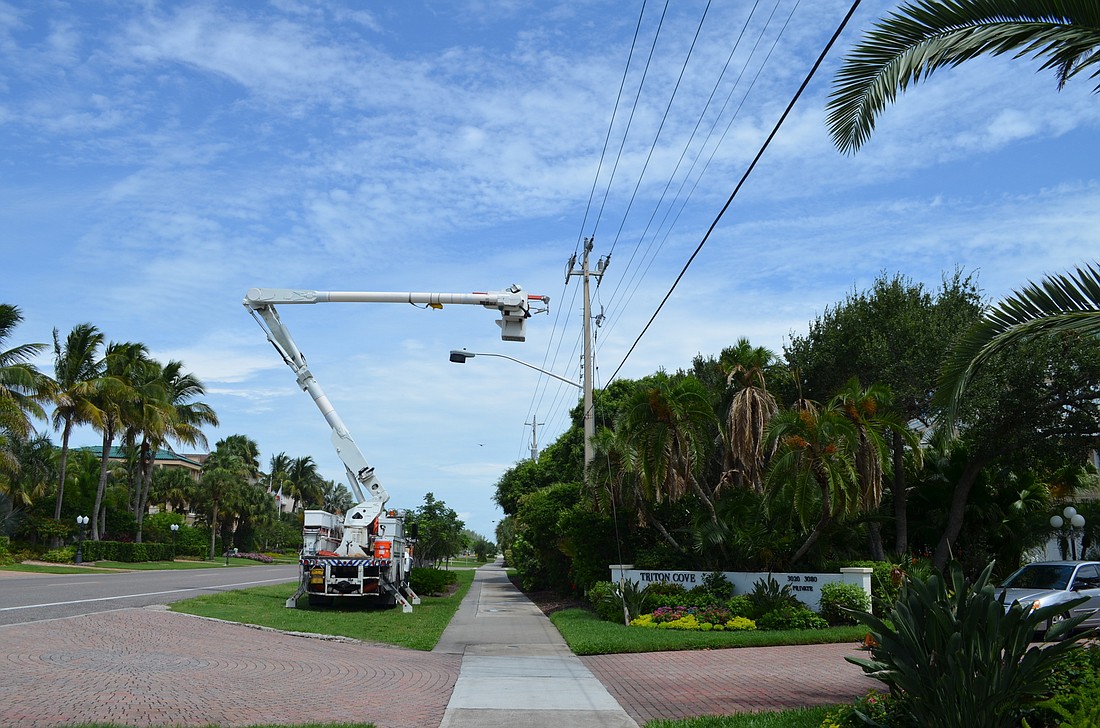- December 21, 2024
-
-
Loading

Loading

Some residents could pay up to $15,811.20 over 30 years to make above-ground wires disappear from the Key.
For others, that cost would be no more than $955.50 over the same period.
Longboat Key’s registered voters will decide March 15, whether to surge ahead or cut the power to a $20.5 million neighborhood and side street power pole and utilities undergrounding project that would bury all utility lines and eliminate every power pole on the island.
The Longboat Key Town Commission voted 6-1 Monday night at its regular meeting to proceed with a referendum asking voters whether the town can issue bonds to bury utility lines in neighborhoods and side streets.
Property owners with existing underground utilities would pay for 18.5% of the project’s cost; owners with above-ground utilities would pay for 81.5%.
Owners of a home with underground utilities on Longboat Club Road would pay $513.35 if they opted to pay for costs upfront. If they financed it over 30 years at a 4.5% interest rate, they would pay $31.85 annually, or $955.50 over 30 years. The interest rate depends on the town’s creditworthiness.
But for a home on St. Judes Drive with overhead utilities, owners would pay a total upfront cost of $8,495.44. Financing costs over 30 years at the same interest rate, they would pay $527.04 annually, for a total cost of $15,811.20.
The proposed referendum question follows the $25.25 million Gulf of Mexico Drive undergrounding project voters approved last month. The average annual extra cost to taxpayers for the Gulf of Mexico Drive project is about $5,400 over 30 years, paid as part of tax bills, or between $153 and $182 per year.
The bottom line on the proposed neighborhood project:
“If this is approved, there will not be any overhead wires left in the town of Longboat Key,” said Town Manager Dave Bullock.
The project would also eliminate 80 to 90 power poles that would otherwise need to be added near Gulf of Mexico Drive to funnel power to neighborhoods with above-ground power lines.
Some question whether those who already have buried power lines and utilities will agree to a referendum that has them paying toward burying properties with above-ground utilities.
If the project is approved, the town will ask a judge to validate the bonds in case of legal challenges. But some commissioners worry the project won’t get the blessing of the judge, who must determine that there’s an islandwide benefit to the project.
Town staff and counsel say it’s reasonable to spread out costs because connecting utilities to future underground lines on Gulf of Mexico Drive would increase reliability, safety and aesthetics for all residents.
The commission also gave Bullock direction to extend a proposed fiber optic network to the approximately 5,000 residents who currently have underground utilities for an extra cost of about $2.7 million.
That amounts to approximately $30 annually over 30 years and will allow the whole Key to take advantage of a future network that will allow for faster broadband Internet speeds, enhance emergency personnel communication and offer other incentives for residents and town staff.
“We’ve already said the fiber optic network is a good thing for Gulf of Mexico Drive and the neighborhoods,” said Commissioner Pat Zunz.
Commissioner Lynn Larson agreed, writing in an email to her Country Club Shores constituents Monday after the meeting:
“I believe that adding the fiber for communications in the currently undergrounded neighborhoods is necessary. Hopefully undergrounding currently overhead streets and adding a communication backbone for all neighborhood streets will pass in March making all of Longboat a more modern place to live.”
Country Club Shores resident and islandwide undergrounding supporter Bob Gault believes it’s crucial for the neighborhood project to be approved.
“We must effectively communicate to voters that we must pass this, or we will have 80 to 90 feeder line poles on GMD to bring the underground line up in the air to feed the neighborhood poles and snatch defeat out of the jaws of victory,” Gault said. “These new poles would not only defeat our improved GMD aesthetics but also increase risk of power failure in storms, which is exactly the opposite of our original objective.”
The commission will review referendum language for the neighborhood project on first reading at a special meeting Dec. 14 and is scheduled to approve the language on second reading Jan. 4.